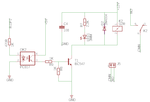venkates2218
Full Member level 6

I'm trying to use PC817 in relay circuit.This is my circuit which I tired the PC817...
This circuit connected with an PIC16F877A controller for switching operation.I checked the controller output with LED which going to switch the relay.The LED is working fine,but the relay not switching ON,their is no response in relay....If the relay is directly ON by direct supply of +12VDC means working...
Is this circuit is correct or have to change in something..?

